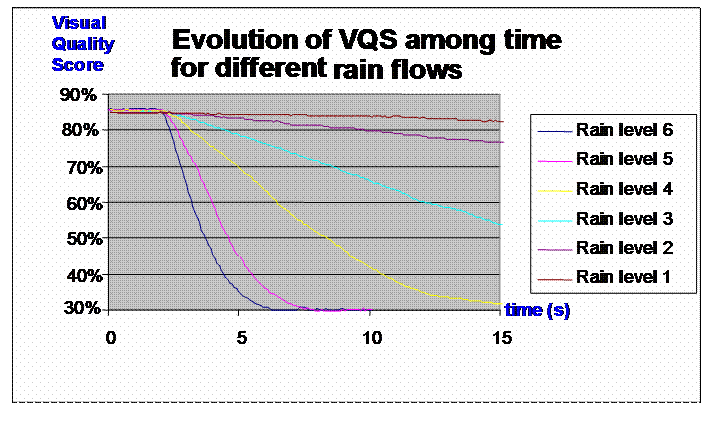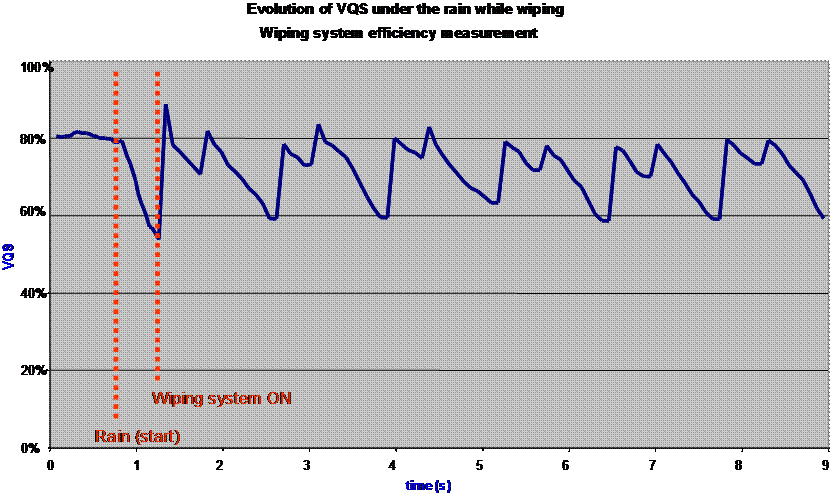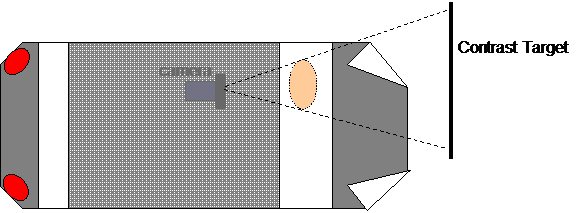


Copyrights NEXYAD 2005-2006 all rights reserved
Terms of use of images and graphics copied from this page : Policy
Keywords
: Visibility measurement, Visibility
through the windshield, wiper tester, VisiNexTM,
Wiper efficiency measurement, rain sensor efficiency measurement,
Frequently Asked Questions, VisiNex FAQ, NEXYAD.
VisiNex FAQ
- What VisiNex application software does ?
VisiNexTM is an artificial vision-based system that looks through the windshield and acquires images focused on a contrast target in front of the car. The camera is inside the car.
Piloted lights and rain (piloted rain machine) make perturbations of the visibility through the windscreen. Every time that the wiper weeps the windshield, visibility is partialy recovered.
VisiNex application software computes visibility scores at every acquisition time stamp.
These scores are highly accurate and allow to make the
difference between 2 wiping strategies or different exhaust levels of
rubbers.
These scores are highly correlated to human impression of understandable image.
These scores are highly correlated to human impression of understandable image.

decreasing
of the Visual Quality Score (one of the NEXYAD visibility scores) in
case of rain

efficiency of the wiper
estimated
in a quantitative way : one can measure the recovery of the visibility
during the wiping cycle
Using this kind normalized NEXYAD visibility score, it is possible to compare two wiper systems and quantitatively show the difference. VisiNex is a complete "wing to wing" measurement system : whatever the perturbation and whatever the technology of the wiper, the only important function is to make sure that visibility through the windshield is okay. VisiNex is wiper technology unsensitive (ifever the wiper is replaced with another technology, the visibility measurement is still needed).
The visibility scores computed among time by VisiNex are :
- the Visual Quality Score (VQS) : correlated to the impression of good quality of the image (good quality means "easy to interpret"),
- the maximum distances of detection for : a pedestrian, a car, a truck, ...
- the maximum distances of recognition for : a pedestrian, a car, a truck, ...
- the minimum size of objects that can be detected or recognize at a given distance (and for a given speed of the car, it means the minimum size of detectable of recognizable objects at a given "time").
- VisiNex is a complete "wing to wing" measurement system ... But if i study just ONE element of the wiper system (for instance : the rain sensor, or maybe the rubber, ...), why should i use VisiNex ?
If one makes 2 measurements with known and reproductable scenarios of light and rain. If only ONE element of the wiper system is changed from a measurement to another, then the variation of the visibility scores from one measurement to the other will be completely due to the studied element.
It is very important, because it means that it is possible to measure the influence of EVERY parameter of the wiper system (example : quality of rubbers, options in the decision making software for automatic wipers, thresholds and presets of rain sensors, ...) on the global efficiency. Then, the combination of all the parameters of the wiper system can be studies through design plans.
- What is the installation scheme ?
A camera is inside the car (or at least behind a windshield). A piloted rain machine sends rain on the windshield. Piloted lights are pointed on a special contrast target (special drawings + special material that has the good "albedo" - reflection characteristics). The camera looks through the windshield and is focused on the contrast target in front of the car.

VisiNex analyzes the modulation of the contrast target among time, and translates it into visibility scores.
When the lights are very low, the visibility is poor, even without rain.
When the rain comes, it makes the visibility (through the windshield) decrease. Wiper allows to recover a part of this visibility. This scores are a quantitative measurement of the efficiency of the wiper system.
- How can i be convinced that your scores are correlated with human eye ?
Models of human eye used in VisiNex come from published research. Mainly from studied published by the US D.O.D. (Department Of Defense) that worked since the 60's on models that should allow to predict the ability of a human being to detect a mimitary body on a natural background. NEXYAD main founders were involved for 20 years in such military researches. VisiNex is an industrial application of these concepts and models.
So scores are correlated to human eye just because they use models of the human eye (and "brain", reference : detection and recognition Johnson criteria).
- Is VisiNEx a real time application ?
No. Images are captured in real time. Analyzes of the images are computed off-line.
- How VisiNex can cope with contrast target aging (white becomes "yellow" and black becomes "grey" with time)?
First, the contrast target is printed on a special material with a special process (NEXYAD tested hundreds of solutions). This printing process leads to the right albedo with rather small fluctuation with time.
And second, calibration procedures compound every small fluctuation of the target albedo.
For the same rain and the same light, NEXYAD guaranties the same scores (repeatability deviation < 1%).
- What happens if we use our own lights ?
NEXYAD engineered a complete hardware and software system that is tested to be good. It doesn't mean that it is not possible to use other hardware devices. For instance, lights are regulated, and many software calibration modules may lead to a similar result even if you use other lights. The only point is that in such a case, you have to validate your scores. NEXYAD can do it for you (through a study). The goal is to make sure that your scores will be the same than the scores of your customers, providers, partners, ... (although it woudn't be possible to compare your measurements with the others). This point is very important because VisiNex is a tool that allows to exchange quantitative data :
- a provider can send an email with the curves of visibility score for a given known scenario : in order to show the very good results they get with an innovative offer.
- a car manufacturer can write a quantitative task book : minimum scores for given scenarios.
Then it is very important to guaranty that scores are reproducable from a VisiNex installation to another (and that is the cas : reproductibility deviation is < 1%).
- Is it possible to plug MY OWN hardware devices ?
Yes. The VisiNex application software is a software brick into the NEXYAD open hardware and software architecture. So it is easily possible to plug any hardware device. The only point to check for hardware devices that modulate the visibility scores (rain machine, lights, wind machine) is the reproductibility of their effect : indeed, the goal of VisiNex is to compare visibility scores for different presets of the wiper system. It means that the perturbation of the visibility must be "exactly the same" for two measurements. The rain machine must send a highly reproductable artificial rain (to be sure that the perturbation of visibility is the same for the two measurements). NEXYAD provides RainNex (a highly reproductable rain machine), but any pilotable rain machine can be plugged into the architecture (if you don't use the NEXYAD RainNex machine, it is your problem to check the reproductibility of your artificial rain, that's all). The reproductibility of a rain machine can be studies with the application software DropNex. The lights must be higly reproductable (The NEXYAD rack regulates the voltage of the lights). The wind machine must send a highly reproductable air flow (force, temperature, humidity, ...). If you are sure that your hardware devices bring highly reproductable pertirbations of the visibility, then you can easily integrate them into the architecture (communication through files of open format scripts).
- Is it possible to plug VisiNex into MY hardware architecture ?
Yes. If you already have a hardware architecture with a rain machine, a wind machine, piloted lights, ... you can plug the VisiNex application software into this architecture as soon as you feed it with the expected data and the right format of files (fully described for integration).
- Other questions ?
Please feel free to contact us : gyahiaoui@nexyad.com +33 (0)139 04 13 60